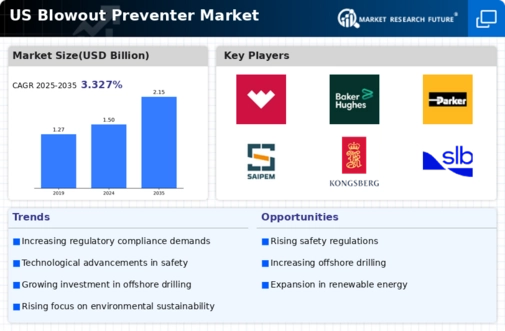Focus on Environmental Protection
The increasing emphasis on environmental protection is shaping the blowout preventer market. As public awareness of environmental issues grows, regulatory bodies are implementing stricter guidelines for drilling operations. This trend compels companies to invest in high-quality blowout preventers to minimize the risk of environmental disasters. In 2025, it is estimated that compliance with environmental regulations could drive a 5% increase in market demand. The blowout preventer market is thus likely to benefit from this focus on sustainability, as operators seek to enhance their environmental stewardship and avoid costly penalties associated with non-compliance.
Increasing Demand for Safety Equipment
The blowout preventer market is experiencing a notable surge in demand driven by heightened safety regulations in the oil and gas sector. As companies strive to mitigate risks associated with drilling operations, the adoption of advanced blowout preventers has become essential. In 2025, the market is projected to reach approximately $1.5 billion, reflecting a compound annual growth rate (CAGR) of around 6.5% from previous years. This growth is largely attributed to the increasing awareness of safety protocols and the necessity for reliable equipment to prevent blowouts. The blowout preventer market is thus positioned to benefit from this trend, as operators prioritize investments in safety technologies to comply with stringent regulations and enhance operational reliability.
Investment in Oil and Gas Infrastructure
Investment in oil and gas infrastructure is a critical driver for the blowout preventer market. As the US government and private sector stakeholders allocate substantial funds towards enhancing drilling capabilities, the demand for blowout preventers is expected to rise. In 2025, infrastructure investments are projected to exceed $200 billion, with a significant portion directed towards safety equipment. This influx of capital is likely to bolster the blowout preventer market, as companies prioritize the acquisition of advanced systems to meet operational demands and regulatory requirements. The focus on infrastructure development is anticipated to create a favorable environment for market growth, as safety remains a top priority in drilling operations.
Technological Innovations in Blowout Preventers
Technological advancements are significantly influencing the blowout preventer market, as manufacturers develop more sophisticated and efficient systems. Innovations such as remote monitoring capabilities and automated control systems are becoming increasingly prevalent. These advancements not only improve the reliability of blowout preventers but also enhance their operational efficiency. In 2025, it is estimated that the integration of smart technologies could account for nearly 30% of the market share. The blowout preventer market is thus likely to see a shift towards more intelligent systems that can provide real-time data and predictive maintenance, ultimately reducing downtime and operational costs for drilling companies.
Rising Exploration Activities in Unconventional Resources
The ongoing exploration of unconventional oil and gas resources, such as shale and deepwater reserves, is driving the blowout preventer market. As operators venture into more challenging environments, the need for robust blowout prevention systems becomes paramount. In 2025, the market is expected to witness a significant increase in demand, with projections indicating a growth rate of approximately 7% annually. This trend is fueled by the potential for high returns on investment in unconventional resources, prompting companies to invest in advanced blowout preventers. The blowout preventer market is thus poised to capitalize on this exploration boom, as operators seek to ensure safety and compliance in their drilling operations.




















Leave a Comment